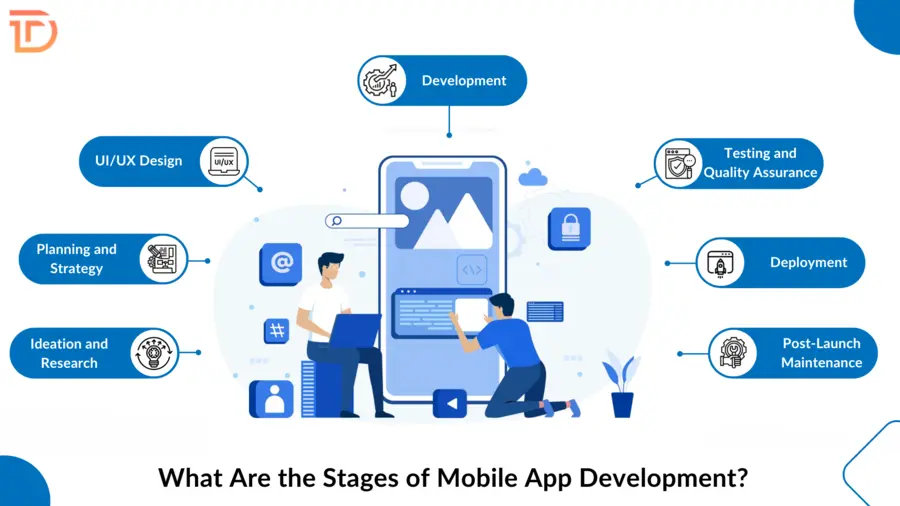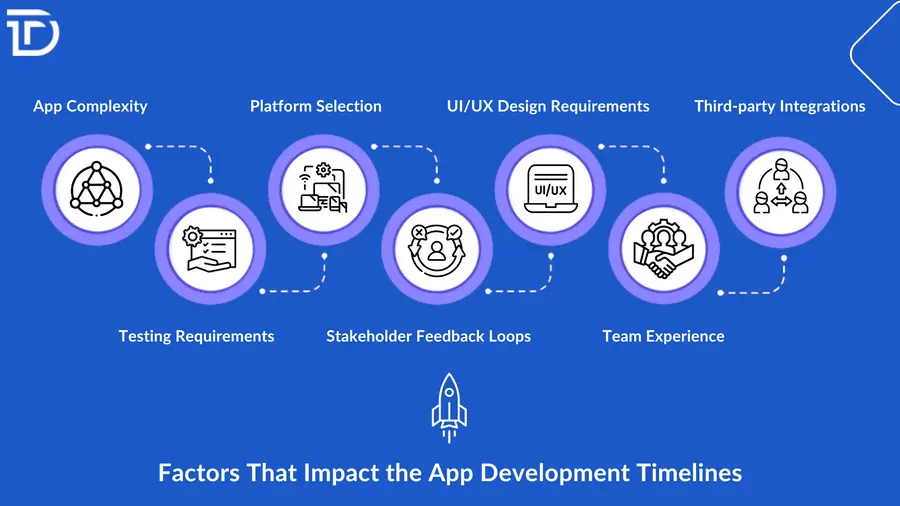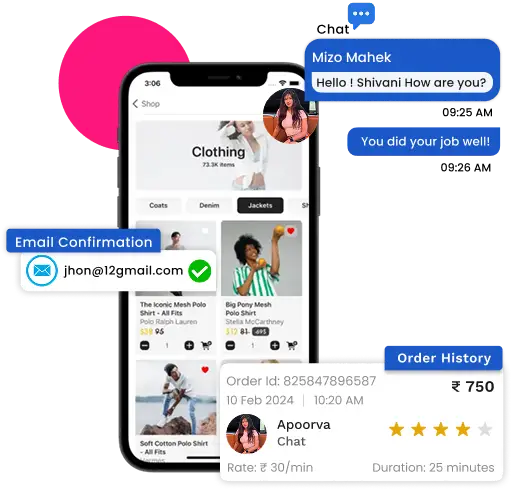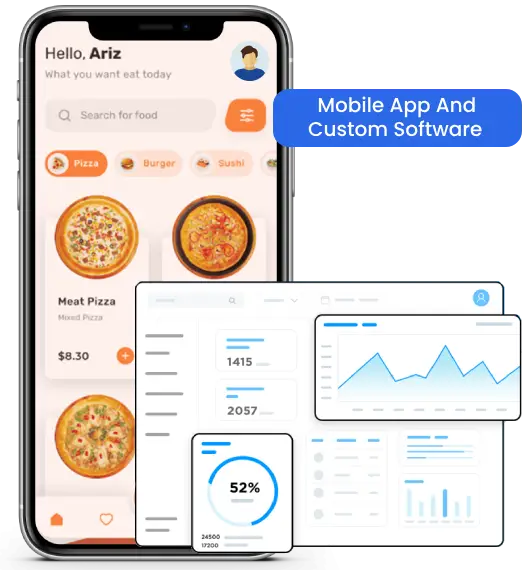Creating a mobile app might appear simple at first, but the journey from concept to launch demands far more than just writing code. It involves research, design, development, testing, and ongoing maintenance, all of which require focused collaboration and a structured approach. Every stage has its own timeline, and the overall duration depends on factors like complexity, platform selection, resource availability, and user experience goals. Whether you’re building a new product from scratch or scaling an existing idea, having a clear understanding of how long each phase takes can help avoid delays, manage costs, and deliver a successful outcome. In this blog, we’ll explore the stages of mobile app development time, break down timelines by complexity, and provide strategies for accurately estimating your app’s development time without compromising quality.
What Are the Stages of Mobile App Development?
The development of a mobile app follows a structured lifecycle, with each stage laying the groundwork for the next. Moreover, each phase adds unique value to the process and contributes to the app’s usability, performance, and long-term success. Here are the key stages most mobile app projects go through: 
Ideation and Research
At the start, the team shapes ideas into actionable concepts. They clearly define the goal, target audience, user needs, and core functions. The team conducts detailed research to study competitors, analyze market trends, and understand user behavior. They assess technical feasibility to determine whether they can build the concept effectively. Finally, the insights gathered during this stage guide future decisions and help prevent wasted time on unvalidated ideas.
Planning and Strategy
Once the team clarifies the idea, they map out the project blueprint. They outline key user journeys, document technical requirements, and establish a timeline with defined milestones. The team finalizes budget estimates, selects platforms, and plans resources to keep everything aligned. With a detailed strategy in place, the team works through the development cycle with clear priorities and responsibilities.
UI/UX Design
Designers start shaping the look and feel of the app based on usability principles and brand guidelines. Wireframes are drawn to visualize screen flows, followed by high-fidelity mockups that show final layouts. Interactive prototypes allow teams to test and refine the user experience before development begins. Every element, from buttons to animations, is designed to enhance navigation and create a satisfying user experience.
Development
This stage involves actual coding of the app’s front-end and back-end components. Developers build the interface users interact with and connect it to databases, servers, and external services through APIs. The entire architecture is structured to support performance, scalability, and security. Feature sets are implemented in stages, allowing testers to begin working as soon as individual modules are completed.
Testing and Quality Assurance
The QA team rigorously tests each function of the app across different devices and operating systems. They identify and resolve bugs, crashes, and usability flaws early to prevent issues after launch. The team performs functional testing, conducts performance checks, and runs security validations using both manual and automated methods. They prioritize ensuring the app performs smoothly and behaves consistently across platforms.
Deployment
After successful testing, the app is made ready for release. Deployment involves creating builds, generating store assets, and submitting the app to platforms like the App Store or Google Play. Compliance with store guidelines, metadata optimization, and final security checks are completed before approval. Once approved, users can download the app, and its live performance can be tracked through analytics.
Post-Launch Maintenance
After going live, the journey doesn’t stop. Consequently, user feedback is collected to spot improvement areas. Updates are regularly rolled out to add features, patch bugs, and improve performance. Compatibility with new OS versions, devices, and security standards is maintained over time. As a result, a well-maintained app stays relevant, competitive, and capable of retaining users for the long run.
Mobile App Development Time by Stages
Timelines vary from project to project, but each stage usually takes a predictable amount of time depending on the scale of the work.
| Stage | Time Estimate | Description |
|---|---|---|
| Ideation & Research | 1–2 weeks | Gather information, validate ideas, and define user needs. Discuss app goals, evaluate challenges, analyze competitors, and build a strong foundation for the project. |
| Planning & Strategy | 1–2 weeks | Create a structured plan including timelines, app architecture, user journeys, and team responsibilities. Define development workflow and sprint plans. |
| UI/UX Design | 2–4 weeks | Design wireframes and high-fidelity mockups. Create interactive prototypes and gather user feedback. Refine design for usability and user experience. |
| Development | 6–16 weeks | Code front-end and back-end, configure databases, and integrate APIs. Develop features iteratively with continuous testing and adjustments. Timeline varies by complexity and platforms. |
| Testing & QA | 2–4 weeks | Conduct manual and automated tests to find bugs, verify performance, and ensure functionality across devices and screen sizes. Prepare for launch readiness. |
| Deployment | ~1 week | Finalize build files, add metadata, follow store submission guidelines, and launch on platforms (App Store/Google Play). Approval times may vary. |
| Post-Launch Maintenance | Ongoing | Provide regular updates, fix bugs, add features, and ensure compatibility with OS changes. Maintain performance and security over time. |
Development Time Breakdown Over App Complexity Type
Time needed to build a mobile app depends heavily on how complex the app is. Apps with simple functions can be completed quickly, while those with advanced features, multiple integrations, or heavy backend processing need more time and resources.
| App Complexity | Estimated Timeline | Description |
|---|---|---|
| Simple App | 2–3 months | Focuses on core features like user registration, basic navigation, and content display. Examples include calculators, news readers, and brochures. Limited screens and no third-party integrations allow for quick development with a small team and minimal revisions. |
| Moderate Complexity App | 3–6 months | Includes interactive features such as user profiles, chat, GPS, push notifications, and external integrations (e.g., payments, social logins). Requires backend development, team coordination, and more extensive planning and testing. |
| Highly Complex App | 6–12 months or more | Advanced features like real-time messaging, video streaming, machine learning, offline support, and complex infrastructure. Emphasizes security, scalability, deep testing, and frequent updates. Often used for enterprise or large-scale consumer apps. |
What Are the Most Time-consuming Stages?
Out of all development stages, the coding phase demands the most time and resources. Building the front-end and back-end components while managing server communications, integrations, and UI elements takes considerable effort. Custom feature development, complex database structures, and high-performance logic slow down the process further.
Another time-intensive segment is the design phase, especially when designing for multiple platforms with unique screen sizes and interaction patterns. Visual consistency, accessibility, and responsive layout all contribute to a longer design window.
Testing may also extend timelines when multiple devices, operating systems, or third-party integrations require thorough compatibility checks. Ensuring the app is bug-free across diverse environments can turn into a prolonged cycle of fixes and re-verifications.
What Are the Factors That Impact the App Development Timelines?
Several factors influence how long it takes to build a mobile app. When planned and managed well, they can help speed things up, but if overlooked, they often lead to unexpected delays.

App Complexity:
The more complex the app, the longer it takes to build. A basic application with login, profile setup, and content viewing usually comes together quickly. Once the development team adds advanced functions like real‑time chat, background syncing, or artificial intelligence, the workload increases sharply. These additional screens, user flows, and technical features require more time for the team to design, code, and test.
Platform Selection:
Choosing whether to develop for Android, iOS, or both can impact the timeline significantly. Creating an app for one platform generally takes less time than building two separate native versions. Cross-platform tools offer a middle ground by allowing code reuse, but native apps often deliver better performance. Supporting multiple platforms demands additional development and testing cycles, which increases the total time.
UI/UX Design Requirements:
The design stage becomes longer when the app demands custom visuals or detailed user experiences. Basic layouts can be produced faster, while highly stylized interfaces with animations, transitions, and personalized interactions take more effort. Making the design intuitive and attractive often involves rounds of feedback, testing prototypes, and fine-tuning every screen for optimal usability.
Third-party Integrations:
Many apps rely on external services for functions like payments, analytics, messaging, or social logins. Integrating these services requires not only setting up the connections but also ensuring they work smoothly with the existing system. Delays often happen when third-party tools are poorly documented, change unexpectedly, or face downtime. Each integration must also be tested to prevent glitches in real-time use.
Team Experience:
A skilled team with experience in app development tends to move faster. Developers who have handled similar projects can identify risks early, apply best practices, and write cleaner code. Moreover, teams lacking expertise may need more time to research solutions or fix mistakes. Productivity increases when the team is familiar with the chosen technology stack and follows a clear workflow.
Stakeholder Feedback Loops:
Feedback plays a vital role in shaping the final product, but delayed responses can interrupt momentum. When clients or stakeholders take too long to review designs, approve features, or respond to queries, the timeline suffers. Frequent changes in direction or unclear communication can also cause rework, which adds days or even weeks to the overall schedule.
Testing Requirements:
Apps that require high levels of testing usually take longer to complete. Some projects demand security checks, device compatibility testing, accessibility validation, or multilingual support. These tasks often require special tools, skilled testers, and additional development cycles to address issues found during review. The more extensive the testing needs, the more time is added to the delivery plan.
Is There a Standard Timeline for All Mobile Apps?
Mobile app development time estimates vary widely based on the specific needs of each project. While some apps can be ready for launch within a few weeks, others may take several months or even close to a year. Every app involves its own set of requirements, features, platforms, and goals. Rushing development or forcing it into a fixed schedule often leads to reduced quality or unexpected increase in mobile app development costs.
Timelines must reflect the app’s end goals. A feature-rich customer-facing app and a simple internal tool both count as mobile apps, but their development needs differ dramatically. Standardized timelines often ignore critical differences and can set unrealistic expectations. Furthermore, flexibility and open communication ensure that every development stage gets the attention it deserves.
Can You Speed Things Up Without Sacrificing Quality?
Yes, development can move faster without cutting corners when strategies are well aligned. Starting with a minimum viable product (MVP) lets teams build the core functionality first, gather feedback, and gradually expand. As a result, reusable components and design libraries reduce repetitive work and accelerate visual development.
Agile development methodologies help keep timelines lean by dividing work into short sprints with clear goals. Tools for continuous integration and testing catch errors early, preventing long debugging sessions later. Automation in deployment and testing also shortens turnaround time.
Speed must never come at the cost of usability, performance, or stability. Clear communication, defined priorities, and experienced collaborators ensure faster progress while maintaining product integrity.
Final Words
Timeframes for mobile app development hinge on careful planning, clarity of purpose, and thoughtful decisions throughout the process. While speed matters, the true goal is building something reliable, functional, and built to last. Success comes not from rushing but from following a well-structured path that avoids unnecessary delays and setbacks. Every successful app begins with a clear vision and follows a series of intentional steps that turn that vision into a working product. When expectations are realistic and teams stay aligned, the result is a high-quality app that meets user needs and delivers long-term value.
If you’re seeking a mobile app development services provider that brings your idea to life with precision and care, Dreamer Technoland offers custom mobile app development tailored to your goals. Our experienced team crafts scalable, user-friendly apps that fit your timeline and business objectives. Whether you’re starting from scratch or improving an existing product, we’re here to turn your vision into a high-performing mobile solution.







